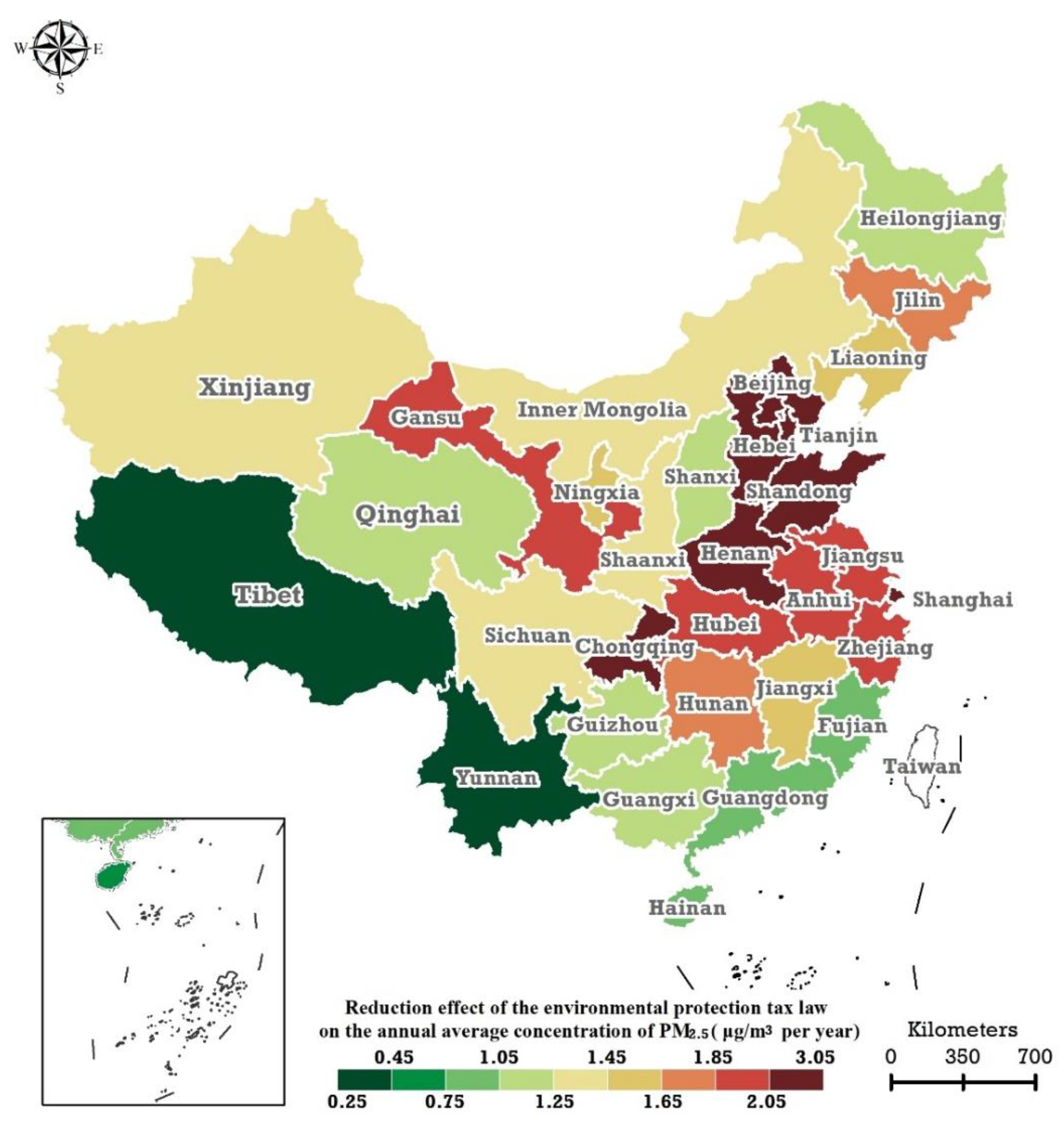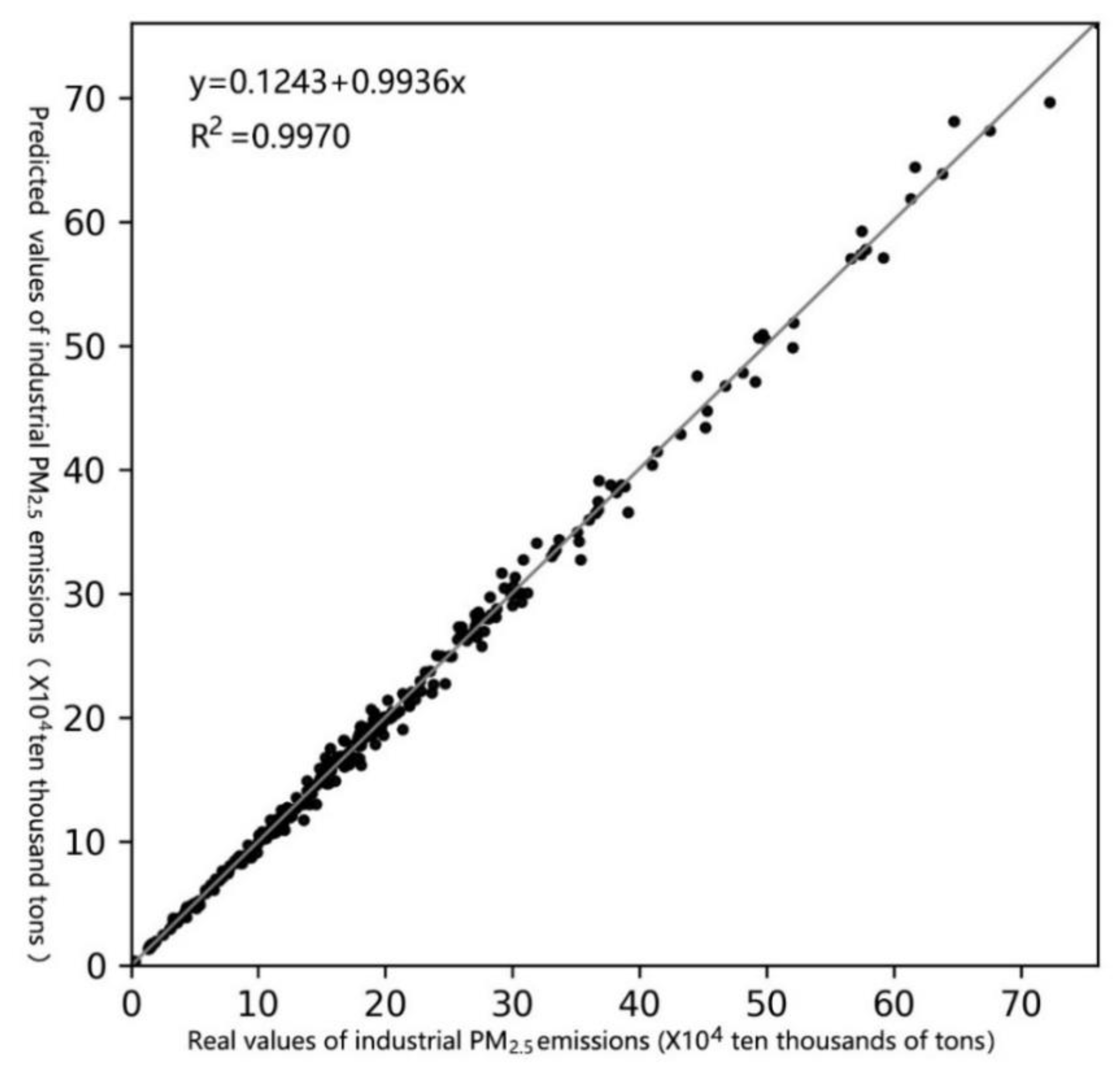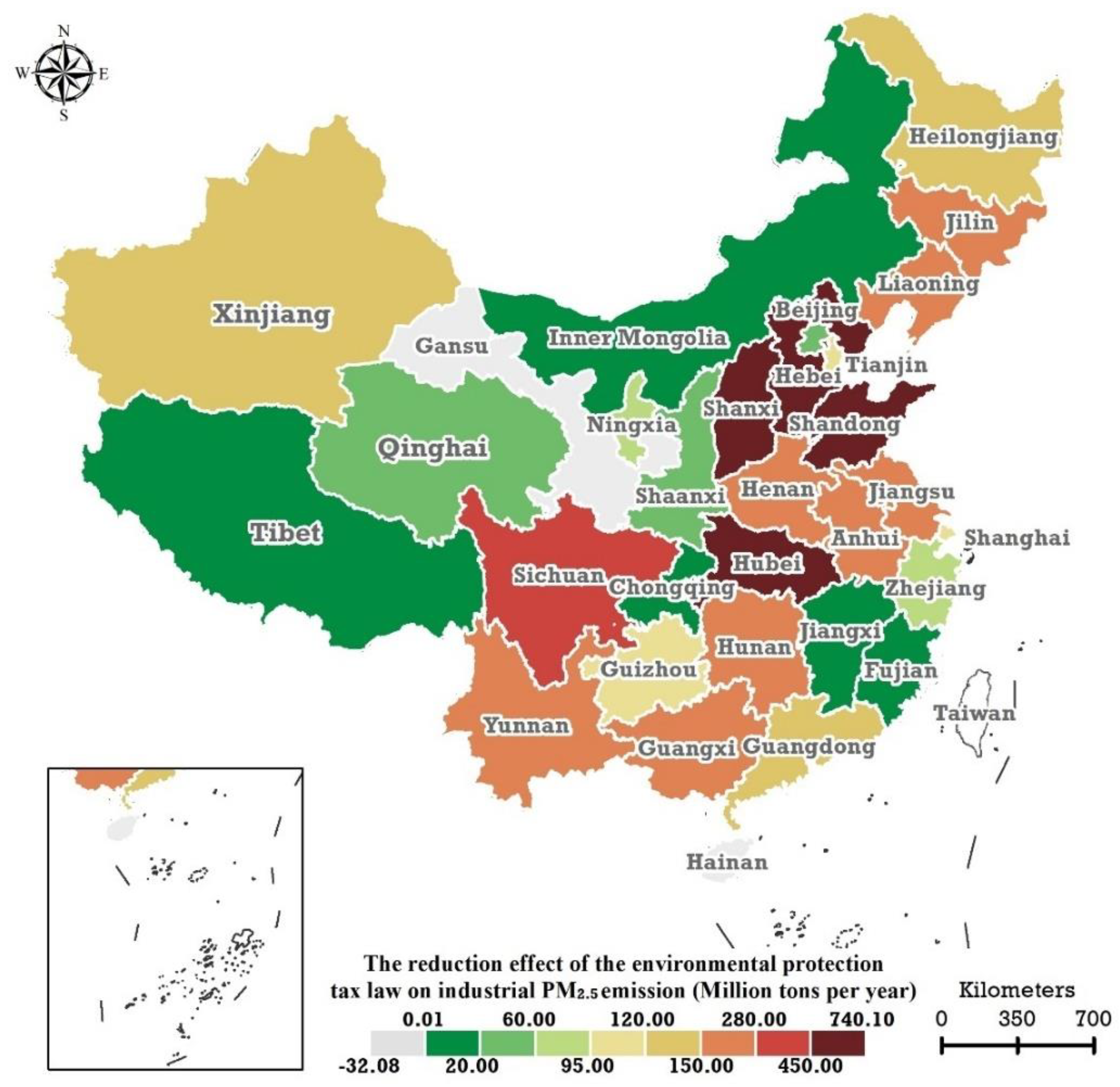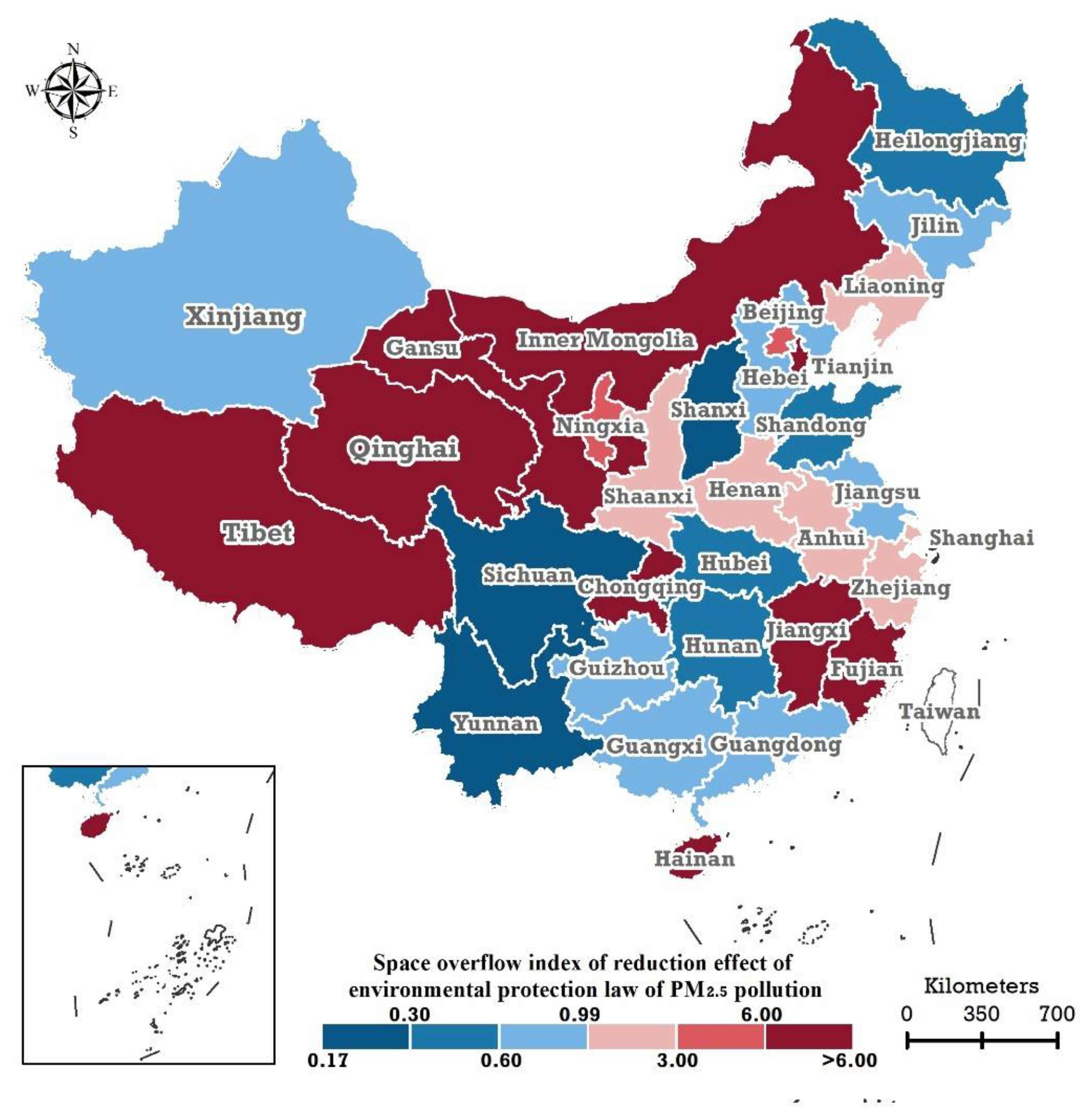Spatial Pattern and Spillover of Abatement Effect of Chinese Environmental Protection Tax Law on PM2.5 Pollution
Abstract
:1. Introduction
2. Materials and Methods
2.1. Materials and Pre-Processing
2.2. Estimating the PATIPME of China in 2018 and 2019
2.3. Estimating the AEEPTLPM
2.3.1. The Overall Idea
2.3.2. Estimating Local Trends
2.4. A Spatial Spillover Index of the AEEPTLPM
3. Results
3.1. AEEPTL on In-Situ-Monitored PM2.5 Concentrations
3.2. AEEPTL on Local Industrial PM2.5 Emissions
3.2.1. Estimation Accuracy of the PATIPME
3.2.2. Estimation of the AEEPTL on Local Industrial Emissions
3.3. SSI of the AEEPTLPM
4. Discussion
5. Conclusions
Supplementary Materials
Author Contributions
Funding
Institutional Review Board Statement
Informed Consent Statement
Data Availability Statement
Acknowledgments
Conflicts of Interest
References
- Turner, M.C.; Andersen, Z.J.; Baccarelli, A.; Diver, W.R.; Gapstur, S.M.; Pope, C.A., III; Prada, D.; Samet, J.; Thurston, G.; Cohen, A. Outdoor air pollution and cancer: An overview of the current evidence and public health recommendations. CA Cancer J. Clin. 2020, 70, 460–479. [Google Scholar] [CrossRef] [PubMed]
- Li, G.; Fang, C.; Wang, S.; Sun, S. The effect of economic growth, urbanization, and industrialization on fine particulate matter (PM2.5) concentrations in China. Environ. Sci. Technol. 2016, 50, 11452–11459. [Google Scholar] [CrossRef] [PubMed]
- Huang, J.; Pan, X.; Guo, X.; Li, G. Health impact of China’s Air Pollution Prevention and Control Action Plan: An analysis of national air quality monitoring and mortality data. Lancet Planet. Health 2018, 2, e313–e323. [Google Scholar] [CrossRef] [Green Version]
- Liu, T.; Cai, Y.; Feng, B.; Cao, G.; Lin, H.; Xiao, J.; Li, X.; Liu, S.; Pei, L.; Fu, L. Long-term mortality benefits of air quality improvement during the twelfth five-year-plan period in 31 provincial capital cities of China. Atmos. Environ. 2018, 173, 53–61. [Google Scholar] [CrossRef]
- Sun, D.; Fang, J.; Sun, J. Health-related benefits of air quality improvement from coal control in China: Evidence from the Jing-Jin-Ji region. Resour. Conserv. Recycl. 2018, 129, 416–423. [Google Scholar] [CrossRef]
- Cheng, J.; Su, J.; Cui, T.; Li, X.; Dong, X.; Sun, F.; Yang, Y.; Tong, D.; Zheng, Y.; Li, Y. Dominant role of emission reduction in PM2.5 air quality improvement in Beijing during 2013–2017: A model-based decomposition analysis. Atmos. Chem. Phys. 2019, 19, 6125–6146. [Google Scholar] [CrossRef] [Green Version]
- Roth, G.A.; Abate, D.; Abate, K.H.; Abay, S.M.; Abbafati, C.; Abbasi, N.; Abbastabar, H.; Abd-Allah, F.; Abdela, J.; Abdelalim, A. Global, regional, and national age-sex-specific mortality for 282 causes of death in 195 countries and territories, 1980–2017: A systematic analysis for the Global Burden of Disease Study 2017. Lancet 2018, 392, 1736–1788. [Google Scholar] [CrossRef] [Green Version]
- Yue, H.; He, C.; Huang, Q.; Yin, D.; Bryan, B.A. Stronger policy required to substantially reduce deaths from PM2.5 pollution in China. Nat. Commun. 2020, 11, 1–10. [Google Scholar] [CrossRef] [Green Version]
- Ren, S.; Li, X.; Yuan, B.; Li, D.; Chen, X. The effects of three types of environmental regulation on eco-efficiency: A cross-region analysis in China. J. Clean. Prod. 2018, 173, 245–255. [Google Scholar] [CrossRef]
- Pigou, A.C.; Aslanbeigui, N. The Economics of Welfare; Routledge: Abingdon, UK, 2017. [Google Scholar]
- Feinerman, E.; Plessner, Y.; DiSegni Eshel, D.M. Recycled effluent: Should the polluter pay? Am. J. Agric. Econ. 2001, 83, 958–971. [Google Scholar] [CrossRef]
- Lin, B.; Li, X. The effect of carbon tax on per capita CO2 emissions. Energy Policy 2011, 39, 5137–5146. [Google Scholar] [CrossRef]
- Tang, L.; Shi, J.; Yu, L.; Bao, Q. Economic and environmental influences of coal resource tax in China: A dynamic computable general equilibrium approach. Resour. Conserv. Recycl. 2017, 117, 34–44. [Google Scholar] [CrossRef]
- Hu, X.; Liu, Y.; Yang, L.; Shi, Q.; Zhang, W.; Zhong, C. SO2 emission reduction decomposition of environmental tax based on different consumption tax refunds. J. Clean. Prod. 2018, 186, 997–1010. [Google Scholar] [CrossRef]
- Murray, B.; Rivers, N. British Columbia’s revenue-neutral carbon tax: A review of the latest “grand experiment” in environmental policy. Energy Policy 2015, 86, 674–683. [Google Scholar] [CrossRef]
- Allan, G.; Lecca, P.; McGregor, P.; Swales, K. The economic and environmental impact of a carbon tax for Scotland: A computable general equilibrium analysis. Ecol. Econ. 2014, 100, 40–50. [Google Scholar] [CrossRef] [Green Version]
- Liu, H.; Lin, B. Energy substitution, efficiency, and the effects of carbon taxation: Evidence from China’s building construction industry. J. Clean. Prod. 2017, 141, 1134–1144. [Google Scholar] [CrossRef]
- Speck, S.; Paleari, S. Environmental taxation and EU environmental policies. Eur. Environ. Agency Cph. Den. 2016, 17, 1–92. [Google Scholar]
- Dasgupta, S.; Laplante, B.; Wang, H.; Wheeler, D. Confronting the environmental Kuznets curve. J. Econ. Perspect. 2002, 16, 147–168. [Google Scholar] [CrossRef] [Green Version]
- Hettige, H.; Mani, M.; Wheeler, D. Industrial pollution in economic development: The environmental Kuznets curve revisited. J. Dev. Econ. 2000, 62, 445–476. [Google Scholar] [CrossRef]
- Larsen, S.M.; Khursheed, A.F. Environmental Regulations and Economic Performance: Evidence from Ozone Attainment Status. Available online: http://www.epa.gov/ttnecas1/workingpapers/ozone.pdf (accessed on 6 June 2021).
- González, R.; Hosoda, E.B. Environmental impact of aircraft emissions and aviation fuel tax in Japan. J. Air Transp. Manag. 2016, 57, 234–240. [Google Scholar] [CrossRef]
- Han, F.; Li, J. Assessing impacts and determinants of China’s environmental protection tax on improving air quality at provincial level based on Bayesian statistics. J. Environ. Manag. 2020, 271, 111017. [Google Scholar] [CrossRef] [PubMed]
- Gray, W.B.; Shadbegian, R. When Do Firms Shift Production across States to Avoid Environmental Regulation? National Bureau of Economic Research: Cambridge, MA, USA, 2002. [Google Scholar]
- Zeng, D.-Z.; Zhao, L. Pollution havens and industrial agglomeration. J. Environ. Econ. Manag. 2009, 58, 141–153. [Google Scholar] [CrossRef] [Green Version]
- Feng, T.; Du, H.; Lin, Z.; Zuo, J. Spatial spillover effects of environmental regulations on air pollution: Evidence from urban agglomerations in China. J. Environ. Manag. 2020, 272, 110998. [Google Scholar] [CrossRef] [PubMed]
- Shao, S.; Li, X.; Cao, J.; Yang, L. China’s economic policy choices for governing smog pollution based on spatial spillover effects. Econ. Res. J. 2016, 9, 73–88. [Google Scholar]
- Yan, D.; Lei, Y.; Shi, Y.; Zhu, Q.; Li, L.; Zhang, Z. Evolution of the spatiotemporal pattern of PM2.5 concentrations in China–A case study from the Beijing-Tianjin-Hebei region. Atmos. Environ. 2018, 183, 225–233. [Google Scholar] [CrossRef] [Green Version]
- Liu, Z.; Deng, H.; Su, Q.; Liu, J.; Hu, W. Stability and diffusion properties of Ti atom on α-uranium surfaces: A first-principles study. Comput. Mater. Sci. 2015, 97, 201–208. [Google Scholar] [CrossRef]
- Zheng, J.; Zhang, L.; Che, W.; Zheng, Z.; Yin, S. A highly resolved temporal and spatial air pollutant emission inventory for the Pearl River Delta region, China and its uncertainty assessment. Atmos. Environ. 2009, 43, 5112–5122. [Google Scholar] [CrossRef]
- Cheng, Z.; Li, L.; Liu, J. Identifying the spatial effects and driving factors of urban PM2.5 pollution in China. Ecol. Indic. 2017, 82, 61–75. [Google Scholar] [CrossRef]
- Du, Y.; Sun, T.; Peng, J.; Fang, K.; Liu, Y.; Yang, Y.; Wang, Y. Direct and spillover effects of urbanization on PM2.5 concentrations in China’s top three urban agglomerations. J. Clean. Prod. 2018, 190, 72–83. [Google Scholar] [CrossRef]
- Li, F.; Xiao, X.; Xie, W.; Ma, D.; Song, Z.; Liu, K. Estimating air pollution transfer by interprovincial electricity transmissions: The case study of the Yangtze River Delta Region of China. J. Clean. Prod. 2018, 183, 56–66. [Google Scholar] [CrossRef]
- Van Donkelaar, A.; Martin, R.V.; Brauer, M.; Hsu, N.C.; Kahn, R.A.; Levy, R.C.; Lyapustin, A.; Sayer, A.M.; Winker, D.M. Global estimates of fine particulate matter using a combined geophysical-statistical method with information from satellites, models, and monitors. Environ. Sci. Technol. 2016, 50, 3762–3772. [Google Scholar] [CrossRef] [PubMed]
- Hammer, M.S.; van Donkelaar, A.; Li, C.; Lyapustin, A.; Sayer, A.M.; Hsu, N.C.; Levy, R.C.; Garay, M.; Kalashnikova, O.; Kahn, R.A. Global Estimates and Long-Term Trends of Fine Particulate Matter Concentrations (1998–2018). Environ. Sci. Technol. 2020, 54, 7879–7890. [Google Scholar] [CrossRef] [PubMed]
- Li, M.; Liu, H.; Geng, G.; Hong, C.; Liu, F.; Song, Y.; Tong, D.; Zheng, B.; Cui, H.; Man, H. Anthropogenic emission inventories in China: A review. Natl. Sci. Rev. 2017, 4, 834–866. [Google Scholar] [CrossRef]
- Zheng, B.; Tong, D.; Li, M.; Liu, F.; Hong, C.; Geng, G.; Li, H.; Li, X.; Peng, L.; Qi, J. Trends in China’s anthropogenic emissions since 2010 as the consequence of clean air actions. Atmos. Chem. Phys. 2018, 18, 14095–14111. [Google Scholar] [CrossRef] [Green Version]
- Song, C.; Shi, X.; Bo, Y.; Wang, J.; Wang, Y.; Huang, D. Exploring spatiotemporal nonstationary effects of climate factors on hand, foot, and mouth disease using Bayesian Spatiotemporally Varying Coefficients (STVC) model in Sichuan, China. Sci. Total Environ. 2019, 648, 550–560. [Google Scholar] [CrossRef]
- Besag, J.; York, J.; Mollié, A. Bayesian image restoration, with two applications in spatial statistics. Ann. Inst. Stat. Math. 1991, 43, 1–20. [Google Scholar] [CrossRef]
- Ding, D.; Xing, J.; Wang, S.; Liu, K.; Hao, J. Estimated Contributions of Emissions Controls, Meteorological Factors, Population Growth, and Changes in Baseline Mortality to Reductions in Ambient PM2.5 and PM2.5-Related Mortality in China, 2013–2017. Environ. Health Perspect. 2019, 127, 067009. [Google Scholar] [CrossRef]
- Zhai, S.; Jacob, D.J.; Wang, X.; Shen, L.; Li, K.; Zhang, Y.; Gui, K.; Zhao, T.; Liao, H. Fine particulate matter (PM2.5) trends in China, 2013–2018: Contribution from meteorology. Atmos. Chem. Phys. 2019, 19, 11031–11041. [Google Scholar] [CrossRef] [Green Version]
- Zhang, Q.; Zheng, Y.; Tong, D.; Shao, M.; Wang, S.; Zhang, Y.; Xu, X.; Wang, J.; He, H.; Liu, W. Drivers of improved PM2.5 air quality in China from 2013 to 2017. Proc. Natl. Acad. Sci. USA 2019, 116, 24463–24469. [Google Scholar] [CrossRef] [Green Version]
- Zhang, J.; Jiang, H.; Zhang, W.; Ma, G.; Wang, Y.; Lu, Y.; Hu, X.; Zhou, J.; Peng, F.; Bi, J. Cost-benefit analysis of China’s Action Plan for Air Pollution Prevention and Control. Front. Eng. Manag. 2019, 6, 524–537. [Google Scholar] [CrossRef]
- Li, G.; Haining, R.; Richardson, S.; Best, N. Space–time variability in burglary risk: A Bayesian spatio-temporal modelling approach. Spat. Stat. 2014, 9, 180–191. [Google Scholar] [CrossRef]
- Bernardinelli, L.; Clayton, D.; Pascutto, C.; Montomoli, C.; Ghislandi, M.; Songini, M. Bayesian analysis of Space—Time variation in disease risk. Stat. Med. 1995, 14, 2433–2443. [Google Scholar] [CrossRef] [PubMed]




| Provincial Region | 2013 | 2014 | 2015 | 2016 | 2017 | RMSE |
|---|---|---|---|---|---|---|
| Beijing | −0.7% | 2.9% | 3.4% | −0.3% | −7.4% | 3.9% |
| Tianjin | −5.5% | 0.2% | 12.6% | 11.5% | −11.5% | 9.5% |
| Hebei | −3.1% | 4.4% | −2.7% | 8.1% | −3.7% | 4.8% |
| Shanxi | −6.5% | −0.3% | 0.5% | 1.9% | 4.9% | 3.8% |
| Inner Mongolia | −1.3% | 1.2% | −2.6% | 8.0% | 0.7% | 3.8% |
| Liaoning | −7.9% | −2.3% | 8.6% | 12.3% | 1.6% | 7.7% |
| Jilin | −10.5% | 12.0% | 6.0% | 8.8% | −3.6% | 8.7% |
| Heilongjiang | −1.7% | 0.7% | 3.6% | 8.3% | −1.1% | 4.1% |
| Shanghai | 3.2% | 2.3% | 5.5% | 3.6% | −7.3% | 4.7% |
| Jiangsu | −1.8% | −6.5% | 3.1% | 5.0% | 4.4% | 4.5% |
| Zhejiang | −2.3% | −4.3% | −3.9% | 10.9% | −0.4% | 5.6% |
| Anhui | −2.4% | −2.0% | −1.1% | 4.7% | 0.3% | 2.6% |
| Fujian | −1.2% | 0.3% | −0.4% | 2.6% | −0.6% | 1.3% |
| Jiangxi | −3.7% | −0.9% | −1.5% | 4.6% | 3.8% | 3.2% |
| Shandong | −1.0% | −0.7% | −1.4% | 4.1% | 1.5% | 2.1% |
| Henan | 0.7% | 0.4% | −0.4% | 3.3% | −2.8% | 2.0% |
| Hubei | −4.1% | 7.5% | −3.2% | 5.6% | −1.4% | 4.8% |
| Hunan | −3.7% | 3.5% | 3.1% | 3.5% | −1.8% | 3.2% |
| Guangdong | −2.3% | −0.2% | 2.6% | 1.1% | −1.0% | 1.7% |
| Guangxi | −1.0% | −3.7% | −1.5% | 9.4% | −1.2% | 4.6% |
| Hainan | −9.5% | −4.3% | 7.1% | −5.6% | 7.3% | 7.0% |
| Chongqing | −6.0% | −6.9% | −0.7% | 6.9% | 5.8% | 5.8% |
| Sichuan | −5.5% | 3.0% | 6.8% | 4.9% | −7.1% | 5.7% |
| Guizhou | −4.8% | −0.2% | 1.3% | −2.3% | 6.2% | 3.7% |
| Yunnan | −3.8% | 4.0% | 1.9% | 3.2% | −2.9% | 3.3% |
| Tibet | −0.3% | 0.5% | 0.4% | −4.3% | 3.4% | 2.5% |
| Shaanxi | −8.5% | −6.1% | −6.9% | 8.4% | 13.1% | 9.0% |
| Gansu | −4.9% | 2.5% | −1.9% | 7.1% | 2.0% | 4.2% |
| Qinghai | −7.2% | 1.6% | 2.3% | 0.1% | 3.2% | 3.8% |
| Ningxia | −3.8% | −3.0% | −4.3% | 10.5% | −0.3% | 5.5% |
| Xinjiang | −4.6% | 0.8% | 5.9% | 2.6% | −5.3% | 4.3% |
| Province | SSI | ||||||
|---|---|---|---|---|---|---|---|
| Beijing | 3.05 | 2.56 | 139.99 | 703.26 | 1.19 | 0.20 | 5.98 |
| Tianjin | 2.71 | 2.48 | 173.29 | 1010.76 | 1.09 | 0.17 | 6.36 |
| Hebei | 2.40 | 1.96 | 1231.31 | 654.16 | 1.22 | 1.88 | 0.65 |
| Shanxi | 1.23 | 1.70 | 980.99 | 281.19 | 0.72 | 3.49 | 0.21 |
| Inner Mongolia | 1.38 | 1.61 | 8.74 | 285.82 | 0.86 | 0.03 | 28.11 |
| Liaoning | 1.59 | 1.74 | 365.22 | 505.25 | 0.91 | 0.72 | 1.26 |
| Jilin | 1.66 | 1.52 | 660.98 | 412.06 | 1.09 | 1.60 | 0.68 |
| Heilongjiang | 1.20 | 1.56 | 492.67 | 354.91 | 0.77 | 1.39 | 0.55 |
| Shanghai | 2.13 | 2.03 | 127.88 | 328.46 | 1.05 | 0.39 | 2.70 |
| Jiangsu | 2.02 | 2.08 | 472.65 | 442.61 | 0.97 | 1.07 | 0.91 |
| Zhejiang | 2.04 | 1.67 | 131.99 | 218.65 | 1.22 | 0.60 | 2.02 |
| Anhui | 1.92 | 1.96 | 308.94 | 477.40 | 0.98 | 0.65 | 1.51 |
| Fujian | 0.82 | 1.41 | 13.68 | 145.54 | 0.58 | 0.09 | 6.17 |
| Jiangxi | 1.52 | 1.64 | 17.22 | 437.64 | 0.93 | 0.04 | 23.63 |
| Shandong | 2.33 | 2.05 | 1003.52 | 498.06 | 1.14 | 2.01 | 0.57 |
| Henan | 2.18 | 1.82 | 357.92 | 467.68 | 1.20 | 0.77 | 1.57 |
| Hubei | 1.98 | 1.76 | 1047.31 | 344.77 | 1.12 | 3.04 | 0.37 |
| Hunan | 1.74 | 1.49 | 616.23 | 313.67 | 1.17 | 1.96 | 0.60 |
| Guangdong | 1.05 | 1.29 | 233.62 | 280.08 | 0.82 | 0.83 | 0.98 |
| Guangxi | 1.10 | 1.04 | 444.46 | 277.23 | 1.06 | 1.60 | 0.66 |
| Hainan | 0.80 | 1.16 | -8.88 | 236.74 | 0.69 | \ | \ |
| Chongqing | 2.12 | 1.44 | 11.46 | 438.58 | 1.47 | 0.03 | 56.26 |
| Sichuan | 1.42 | 1.12 | 1027.05 | 174.14 | 1.27 | 5.90 | 0.22 |
| Guizhou | 1.25 | 1.09 | 375.24 | 319.19 | 1.14 | 1.18 | 0.97 |
| Yunnan | 0.38 | 0.88 | 437.78 | 213.38 | 0.43 | 2.05 | 0.21 |
| Tibet | 0.25 | 1.13 | 5.29 | 158.41 | 0.22 | 0.03 | 6.59 |
| Shaanxi | 1.29 | 1.62 | 73.09 | 244.37 | 0.80 | 0.30 | 2.67 |
| Gansu | 1.97 | 1.39 | -77.44 | 181.36 | 1.41 | \ | \ |
| Qinghai | 1.25 | 1.23 | 32.24 | 200.43 | 1.02 | 0.16 | 6.34 |
| Ningxia | 1.50 | 1.54 | 79.02 | 251.67 | 0.97 | 0.31 | 3.09 |
| Xinjiang | 1.27 | 1.25 | 190.38 | 184.41 | 1.02 | 1.03 | 0.99 |
Publisher’s Note: MDPI stays neutral with regard to jurisdictional claims in published maps and institutional affiliations. |
© 2022 by the authors. Licensee MDPI, Basel, Switzerland. This article is an open access article distributed under the terms and conditions of the Creative Commons Attribution (CC BY) license (https://creativecommons.org/licenses/by/4.0/).
Share and Cite
Han, F.; Li, J. Spatial Pattern and Spillover of Abatement Effect of Chinese Environmental Protection Tax Law on PM2.5 Pollution. Int. J. Environ. Res. Public Health 2022, 19, 1440. https://doi.org/10.3390/ijerph19031440
Han F, Li J. Spatial Pattern and Spillover of Abatement Effect of Chinese Environmental Protection Tax Law on PM2.5 Pollution. International Journal of Environmental Research and Public Health. 2022; 19(3):1440. https://doi.org/10.3390/ijerph19031440
Chicago/Turabian StyleHan, Fei, and Junming Li. 2022. "Spatial Pattern and Spillover of Abatement Effect of Chinese Environmental Protection Tax Law on PM2.5 Pollution" International Journal of Environmental Research and Public Health 19, no. 3: 1440. https://doi.org/10.3390/ijerph19031440
APA StyleHan, F., & Li, J. (2022). Spatial Pattern and Spillover of Abatement Effect of Chinese Environmental Protection Tax Law on PM2.5 Pollution. International Journal of Environmental Research and Public Health, 19(3), 1440. https://doi.org/10.3390/ijerph19031440





